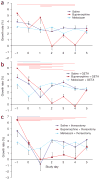Correlation between body weight changes and postoperative pain in rats treated with meloxicam or buprenorphine
- PMID: 19229225
- PMCID: PMC2805902
- DOI: 10.1038/laban0309-87
Correlation between body weight changes and postoperative pain in rats treated with meloxicam or buprenorphine
Abstract
It is essential to identify objective and efficient methods of evaluating postoperative pain in rodents. The authors investigated whether postoperative changes in rates of body weight gain could serve as a measure of the efficacy of meloxicam or buprenorphine analgesia in growing rats. Young adult male Lewis rats underwent general endotracheal anesthesia and thoracotomy and were treated postoperatively for 3 d with saline (no analgesia), buprenorphine (six doses of 0.1 mg per kg) or meloxicam (three doses of 1 mg per kg). The authors evaluated rats' daily growth rates for 5 d after surgery and compared them with baseline (preoperative) growth rates. To discriminate between the effects of postoperative pain and other concurrent physiologic effects associated with anesthesia, thoracotomy or analgesia, the authors evaluated weight changes in multiple control groups. Treatment with buprenorphine in the absence of any other procedure or with anesthesia alone significantly affected rats' body weight. Notably, growth rate was maintained at near normal levels in rats treated postoperatively with meloxicam. These findings suggest that growth rate might serve as an efficient index of postoperative pain after major surgical procedures in young adult rats treated with meloxicam but not in rats treated with buprenorphine.
Conflict of interest statement
The authors declare no competing financial interests.
Figures

References
-
- Liles JH, Flecknell PA. The effects of surgical stimulus on the rat and the influence of analgesic treatment. Br Vet J. 1993;149:515–525. - PubMed
-
- Flecknell PA, Orr HE, Roughan JV, Stewart R. Comparison of the effects of oral or subcutaneous carprofen or ketoprofen in rats undergoing laparotomy. Vet Rec. 1999;144:65–67. - PubMed
-
- Roughan JV, Flecknell PA. Behavioural effects of laparotomy and analgesic effects of ketoprofen and carprofen in rats. Pain. 2001;90:65–74. - PubMed
-
- Jablonski P, Howden BO, Baxter K. Influence of buprenorphine analgesia on post-operative recovery in two strains of rats. Lab Anim. 2001;35:213–222. - PubMed
-
- Flecknell PA. Analgesia of small mammals. Vet Clin North Am Exot Anim Pract. 2001;4:47–56. - PubMed
Publication types
MeSH terms
Substances
Grants and funding
LinkOut - more resources
Full Text Sources
Medical

